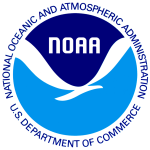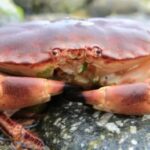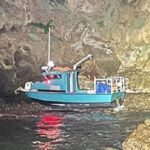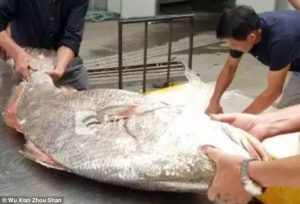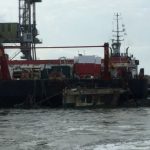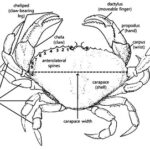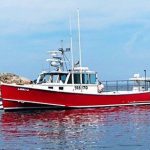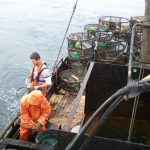Tag Archives: Pacific cod
What You Need to Know About Cod
As a large, naturally abundant fish, cod has been eaten by various human populations for centuries. 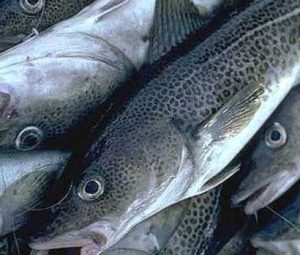 While both of America’s Atlantic cod fisheries are overfished, American stocks of Pacific cod (Gadus macrocephalus) are not. What’s more, various other cod fisheries are located around the globe, some over-exploited, others not. The fish’s prevalence, along with its suitability for eating, means that despite dwindling numbers, cod remains a stalwart of many cuisines. However, there are many things about cod that aren’t widely known. It might surprise some people to learn that cod hunt for prey. They eat a variety of animals, ranging from worms to lobsters and even small fish. Such a diet means cod are capable of growing up to an impressive length of six feet and a weight of over 100 pounds. more, >>click to read<< 11:52
While both of America’s Atlantic cod fisheries are overfished, American stocks of Pacific cod (Gadus macrocephalus) are not. What’s more, various other cod fisheries are located around the globe, some over-exploited, others not. The fish’s prevalence, along with its suitability for eating, means that despite dwindling numbers, cod remains a stalwart of many cuisines. However, there are many things about cod that aren’t widely known. It might surprise some people to learn that cod hunt for prey. They eat a variety of animals, ranging from worms to lobsters and even small fish. Such a diet means cod are capable of growing up to an impressive length of six feet and a weight of over 100 pounds. more, >>click to read<< 11:52
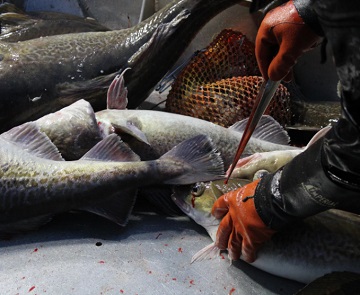
Catch Shares: Commercial trawlers to transition to quota system for Bering Sea and Aleutian Islands cod harvests
Starting in January, the fleet will fish under a “rationalization” system where each catcher vessel will have a maximum catch limit, which will be assigned through quota. The new regulations will require vessels trawling for cod in the area to form cooperatives, and quota will be administered through each co-op. Previously, the entire fishery had a total allowable catch that had to be caught within a certain amount of time. NOAA said this is the first time a catch share program has been implemented in Alaska since 2012. >>click to read<< 09:31
New quota system to start for trawl harvests of cod in Bering Sea and Aleutians
 Commercial fishermen netting Pacific cod from the Bering Sea and Aleutians region will be working under new individual limits starting next year designed to ease pressure on harvests that regulators concluded were too rushed, too dangerous and too prone to accidentally catch untargeted fish species. The new system will require fishers who harvest cod by trawl – the net gear that scoops up fish swimming near the bottom of the ocean – to be part of designated cooperatives that will then have assigned quota shares. The fisheries service at the National Oceanic and Atmospheric Administration said it has notified eligible participants and is asking for applications. >click to read< 08:54
Commercial fishermen netting Pacific cod from the Bering Sea and Aleutians region will be working under new individual limits starting next year designed to ease pressure on harvests that regulators concluded were too rushed, too dangerous and too prone to accidentally catch untargeted fish species. The new system will require fishers who harvest cod by trawl – the net gear that scoops up fish swimming near the bottom of the ocean – to be part of designated cooperatives that will then have assigned quota shares. The fisheries service at the National Oceanic and Atmospheric Administration said it has notified eligible participants and is asking for applications. >click to read< 08:54
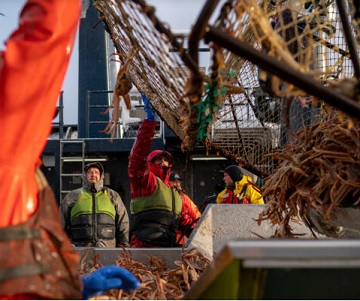
Alaska snow crab fishery saw steep decline. A reporter went ‘Into the ice’ to see it for himself.
CG: Well, at the heart of this reporting that you did were snow crab numbers. So what’s going on with those snow crab numbers? And how steep of a decline have they seen? HB: Well, it’s really pretty stunning for some of the biologists who do the surveys because, of course, in 2020, because of COVID, they were unable to do the summer surveys of crab population. So they did them in 2019. And when they came back in the summer of 2021, they found these staggering drops in abundance of different populations of the snow crab. The juvenile females were down by more than 99%. The juvenile males were also way down. And they’re also less of the mature males and the mature females. So this really triggered a major reassessment of what would be a safe level of harvest for this 2022 season. And they ended up still having a harvest, but reducing it by nearly 90%, >click to read< 16:37
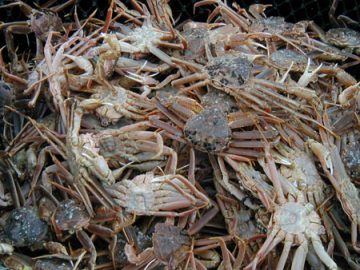
Valuable crab populations are in a ‘very scary’ decline in warming Bering Sea
The forecast for the 2022 winter snow crab season is bleak. At best, it is expected to be considerably less than 12 million pounds. That would be down from a 2021 harvest of 45 million pounds,,, The iconic Bering Sea red king crab, which can grow up to 24 pounds with a leg-span up to 5 feet, also are in trouble. In a big blow to the commercial crabbers, many of whom are based in Washington, the October harvest for these crab has been canceled, something that has only happened three times before. Overall conservation measures are expected to wipe out most of the value of the annual Bering Sea crab harvest, worth more than $160 million during the past year, according to Jamie Goen, executive director of the Seattle-based Alaska Bering Sea Crabbers. >click to read< 13:54
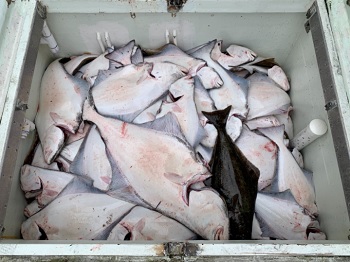
NOAA Fisheries reports on early pandemic impact on fisheries
NOAA Fisheries Friday, January 15 released a report on the economic impact on the seafood catch and recreational fishing nationwide and here in Alaska through last summer.,, Nationwide the commercial fishing industry started off 2020 with increases in revenue from seafood sales. But as the pandemic hit in March, that income dropped off 19 percent compared to the most recent five-year average. Those declines swelled to 45 percent by July. >click to read< 19:25
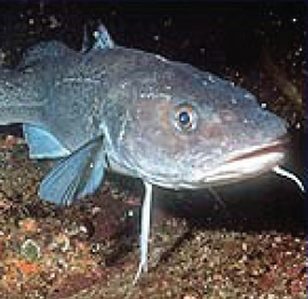
Council turns down petition sought to protect Adak processor
The North Pacific Fishery Management Council decided not to approve an emergency petition from a group of Aleutian Islands stakeholders at its meeting June 9, instead taking a longer route through a discussion to look at the set-aside options for the area. The petition had sought an emergency quota set-aside of Pacific cod, separate from the general Bering Sea-Aleutian Islands quota, to help sustain the shore-based plant and thus the community. >click to read<09:36
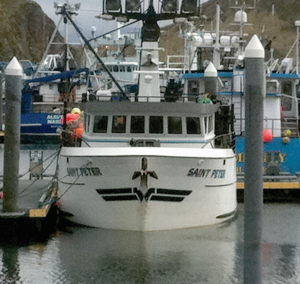
Bering Sea Battle breaks out over growth of ‘Super 8s’ in state cod fishery
The success of the state waters Dutch Harbor Pacific cod fishery in the Bering Sea is scaring both the industrial trawl and longline fleets, and even a local Unalaska fisherman who says a new breed of small boats known as Super 8s are catching way too many fish. In 2014, the new fishery opened with 3 percent of the total Bering Sea cod quota, and two years later it more than doubled to 6.4 percent, by votes of the Alaska Board of Fisheries to promote small boat fisheries. And it may get a lot bigger, as the board will soon hear proposals for growing the fishery to 8, 10 or as much as 20 percent of all the cod available to fishermen in the Bering Sea. >click to read<11:28

Alaskan businesses thrive with state-water cod fisheries
Fishing vessel crews in Western Alaska wrapped up a successful pot-cod season last month, building upon what’s become a mainstay winter fishery for an increasing number of Alaskan boats. Now that pots and gear are stacked and stored, we have time to look ahead at what comes next. As a young skipper within the under-60-foot pot-cod fleet, I see first-hand the value Pacific cod offers to the state. Cod is one of the top-three pillars that resident fishermen build their success upon — alongside salmon and halibut. >click to read<15:58
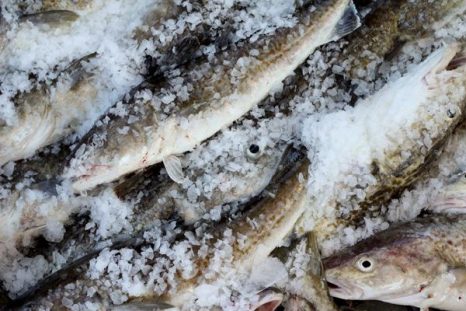
Stay home or go fishing? Homer fishermen grapple with cod decline
Regulators voted to slash Gulf of Alaska Pacific cod allocations 80 percent earlier this month after a massive decline in stocks. That has fishermen and processors around the Gulf deciding what to do when the season kicks off on in January. “It’s going to be a big deal to a bunch of us. I’m guessing we’re going to be looking for stuff to do by the end of February at the latest,” Alray Carroll said.,, Once 2018’s total allowable catch of 13,000 metric tons has been landed, the season is over. click here to read the story 10:44
Strong harvests, more oversight marked 2016 groundfish fisheries
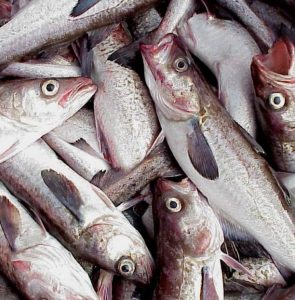 Last year was a good year overall for groundfish fisheries in the region. With a few standout harvests and favorable proposals with the Board of Fisheries, managers are feeling optimistic heading into the new year. The Alaska Department of Fish and Game oversees several groundfish fisheries within the Cook Inlet Management Area, which extends outside of Kachemak Bay to the north Gulf coast. “These fisheries include Pacific cod, sablefish, a directed pelagic shelf rockfish fishery, lingcod, and a small commissioner’s permit Pollock fishery,” said Jan Rumble, Fish and Game area groundfish management biologist. Pacific cod stood out in 2016 as it was open all year long for pot and jig gear in either a parallel or state waters fishery, Rumble said. Read the story here 11:19
Last year was a good year overall for groundfish fisheries in the region. With a few standout harvests and favorable proposals with the Board of Fisheries, managers are feeling optimistic heading into the new year. The Alaska Department of Fish and Game oversees several groundfish fisheries within the Cook Inlet Management Area, which extends outside of Kachemak Bay to the north Gulf coast. “These fisheries include Pacific cod, sablefish, a directed pelagic shelf rockfish fishery, lingcod, and a small commissioner’s permit Pollock fishery,” said Jan Rumble, Fish and Game area groundfish management biologist. Pacific cod stood out in 2016 as it was open all year long for pot and jig gear in either a parallel or state waters fishery, Rumble said. Read the story here 11:19
Pacific cod may have learned to hunt seabirds, research indicates
You could call it revenge on the birds. While many marine birds are well known for their skills at diving into the sea to pluck out fishy meals, there is now solid evidence that some Pacific cod have turned the tables on the avian species. The practice came to light a few years ago when seafood workers in Dutch Harbor noticed that some of the cod they were processing came with extra features — partially digested birds in the fish stomachs. Read the rest here 16:47
Trawlers may convert to pot gear for cod catches
 One of the tools being talked about to help trawlers reduce salmon and halibut bycatch is the opportunity to voluntarily convert to pot gear to catch Pacific cod. It’s an option being discussed by fishery managers as they craft a trawl bycatch reduction plan for the Gulf of Alaska. Sam Cunningham, “The reason someone might be interested in using pot gear, and the reason is that it would have lower bycatch of prohibited species of Chinook salmon and halibut, and when those species are caught incidentally they would be less likely to die because they are caught in pot gear.” Listen, and read the rest here 17:51
One of the tools being talked about to help trawlers reduce salmon and halibut bycatch is the opportunity to voluntarily convert to pot gear to catch Pacific cod. It’s an option being discussed by fishery managers as they craft a trawl bycatch reduction plan for the Gulf of Alaska. Sam Cunningham, “The reason someone might be interested in using pot gear, and the reason is that it would have lower bycatch of prohibited species of Chinook salmon and halibut, and when those species are caught incidentally they would be less likely to die because they are caught in pot gear.” Listen, and read the rest here 17:51
Small boat Pacific cod fishery to open Sept. 1
 Summer fishing in the Bering Sea and Aleutian Islands is winding down, and smaller catcher vessels will have access to an extra 1,700 metric tons of Pacific cod this fall after some quota went unused by other fleets. Krista Milani, from the National Marine Fisheries Service, said her agency typically reallocates unused Pacific cod quota to the smaller fleet toward the end of each summer. Catcher vessels less than 60 feet in length using hook and line gear are only allocated quota for the A season, which begins in January each year,,, Read the rest here 08:26
Summer fishing in the Bering Sea and Aleutian Islands is winding down, and smaller catcher vessels will have access to an extra 1,700 metric tons of Pacific cod this fall after some quota went unused by other fleets. Krista Milani, from the National Marine Fisheries Service, said her agency typically reallocates unused Pacific cod quota to the smaller fleet toward the end of each summer. Catcher vessels less than 60 feet in length using hook and line gear are only allocated quota for the A season, which begins in January each year,,, Read the rest here 08:26
Tradex 3-Minute Market Insight: Bleak Outlook for Collapsed Sole Market; Cod Pricing Creates Buyer Opportunities
 Long inventories, poor markets, and limited cash flow equate to looming troubles ahead for Chinese processing plants. Atlantic Cod pricing remains strong and raw materials are still high, forcing upwards pricing pressure on finished goods headed for North America. is looking like an affordable whitefish alternative. Watch the 3-Minute Market Insight here 14:58
Long inventories, poor markets, and limited cash flow equate to looming troubles ahead for Chinese processing plants. Atlantic Cod pricing remains strong and raw materials are still high, forcing upwards pricing pressure on finished goods headed for North America. is looking like an affordable whitefish alternative. Watch the 3-Minute Market Insight here 14:58
Warming waters pose dangers to Arctic cod, research finds – saffron cod, pollock and Pacific cod could thrive!
 A research project being conducted by National Oceanic and Atmospheric Administration scientists has found that even a moderate warming of waters could spell dire consequences for the Arctic cod, a high-fat fish important to the food web. But other fish with lower fat content — pollock, Pacific cod and saffron cod — can survive and even thrive in warming waters, the research finds. Meanwhile, another NOAA-led study found that larvae of northern rock fish appear to be resilient to increased levels of acidity in marine waters. Read the rest here 19:14
A research project being conducted by National Oceanic and Atmospheric Administration scientists has found that even a moderate warming of waters could spell dire consequences for the Arctic cod, a high-fat fish important to the food web. But other fish with lower fat content — pollock, Pacific cod and saffron cod — can survive and even thrive in warming waters, the research finds. Meanwhile, another NOAA-led study found that larvae of northern rock fish appear to be resilient to increased levels of acidity in marine waters. Read the rest here 19:14
Trawl fleet continuing to fish for Pacific cod, first committee hearing to advance Dr. Roland Maw, lively and contentious!
 The boats fishing for Pacific cod with pots in the central Gulf of Alaska federal season finally wrapped up their 17.9 million pound quota Monday, a few days later than last year, but the trawl fleet is still fishing with only 30 percent of their 9,600-ton quota caught. The boats now move into state waters within three miles of shore,,, Also, As expected, the first committee hearing to advance Dr. Roland Maw to confirmation by the full Legislature to the Alaska Board of Fisheries was lively and contentious. 22:14
The boats fishing for Pacific cod with pots in the central Gulf of Alaska federal season finally wrapped up their 17.9 million pound quota Monday, a few days later than last year, but the trawl fleet is still fishing with only 30 percent of their 9,600-ton quota caught. The boats now move into state waters within three miles of shore,,, Also, As expected, the first committee hearing to advance Dr. Roland Maw to confirmation by the full Legislature to the Alaska Board of Fisheries was lively and contentious. 22:14
Alaska fish processors chase Japanese market for an unusual product — cod semen
 Let’s get one thing out of the way right now: This is a story about cod semen and the people who love to eat it. Right now, fishing boats are pulling Pacific cod from the Bering Sea and Gulf of Alaska. Fisherman are allowed to catch up to 325,000 tons of cod this year. A lot of that cod will become fish sticks or batter-fried filets. But many processors in Alaska also remove the sperm sacs of male cod, a seafood product called cod milt. In Japan, a high-end market exists for cod milt, which goes by the unsettling literal name shirako, or “white children.” Read the rest here 15:25
Let’s get one thing out of the way right now: This is a story about cod semen and the people who love to eat it. Right now, fishing boats are pulling Pacific cod from the Bering Sea and Gulf of Alaska. Fisherman are allowed to catch up to 325,000 tons of cod this year. A lot of that cod will become fish sticks or batter-fried filets. But many processors in Alaska also remove the sperm sacs of male cod, a seafood product called cod milt. In Japan, a high-end market exists for cod milt, which goes by the unsettling literal name shirako, or “white children.” Read the rest here 15:25
Cook Inlet leads Agenda Change Requests for fish board
 In addition to nine Cook Inlet requests, five address Bering Sea tanner crab and Norton Sound king crab, three ask for changes to Kuskokwim River salmon fisheries, and two address Yukon River salmon fisheries. There are also two proposals each for Bristol Bay salmon fisheries, Southeast herring and Pacific cod, as well as one relating to purse seine lengths. Read more here 10:18
In addition to nine Cook Inlet requests, five address Bering Sea tanner crab and Norton Sound king crab, three ask for changes to Kuskokwim River salmon fisheries, and two address Yukon River salmon fisheries. There are also two proposals each for Bristol Bay salmon fisheries, Southeast herring and Pacific cod, as well as one relating to purse seine lengths. Read more here 10:18
NPFMC talks BSAI halibut, Pacific cod
SEATTLE — Bering Sea halibut bycatch will be back on the menu at an upcoming fisheries meeting. The North Pacific Fishery Management Council, or NPFMC, agreed unanimously today to ask for another draft of a Bering Sea halibut bycatch discussion paper. Read more@alaskajournal 14:11



































